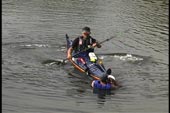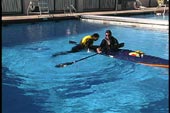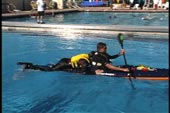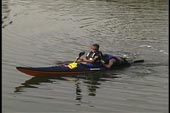Swimmer Assists
There may come a time when your paddling partner loses their boat or you may have a swimmer that needs assistance. In either case you should be prepared with alternatives for helping that swimmer towards shore.
In essence you have three basic alternatives if you do not have a sea worthy boat in which to put the swimmer. You can push the swimmer, pull the swimmer or have the swimmer on your back deck and paddle your kayak and the two of you to shore.
The traditional methods require the swimmer to be conscious. The towing method could also be used on an unconscious paddler if you have the right equipment. Regardless of the method you chose to use I highly recommend practicing them with your partner before you ever need them. The push and pull method are not too difficult. However, when a swimmer tries to climb on your kayak you are going to need excellent bracing skills to keep upright and a good supportive forward stroke to stay upright and move at the same time.
The alternatives that use other kayaks and kayakers are topics for future discussions.
The Bow Push is simple and effective and typically used for short distance transfers. If the swimmer is dressed for immersion there is no reason this method could not be used for longer periods.
The swimmer hangs onto the bow of the kayak while still allowing their PFD to support them. As they are pushed forward their feet will come up along the sides of the kayak. If the swimmer tries to wrap their feet around the top of the kayak they will find it takes more energy on their part and may decrease the stability of the kayak. Experiment with your partner.
Since they are being pushed the swimmers neck is exposed to water. Even if they are wearing a wetsuit more water will run down the neck into the back area increasing the risk of hypothermia if the water is cold.
If the swimmer is not dressed for immersion then this method may not be your best option.

If the swimmer is not dressed for immersion then this will be your best alternative but as mentioned earlier you need to practice this one and perfect your bracing skills.
The Rear Deck Carry can cause an immediate capsize if you and your partner do not communicate. The paddler needs to be very directive in their instructions to the swimmer.
The paddler should get the most leverage they can so I recommend an extended sculling brace on the same side as the swimmer. When you are ready for the swimmer, tell him or her to climb (slide if they can) onto your back deck keeping as low as they can. Once on the back deck ask them to even their body weight so they aren't tipping to one side or the other. Their feet can remain in the water (more stable but more drag) or they can hook their feet on the top of the stern (less drag but less stable) area depending on leg length, kayak size and rudder concerns.


If you thought the climb on phase was tricky, getting under way is even more exciting. Here I recommend a forward sweep stroke with a climbing angle on the blade to act as a mini brace as you pick up speed. The faster you are moving the more stable you will feel. You are going to love the transition from the extended brace to your first forward strokes. Make it a quick transition.
When I practice and/or use this skill I am always ready for a brace. That is why I modify my normal touring stroke to be more of a sweep style stroke.
I cannot emphasis this enough, practice it before you need to use it. The chances are you will be in rough seas if you ever really need this skill.

As for Towing or Pulling a Swimmer you have two possibilities (sorry for the lack of pictures at this time.) The swimmer can hang onto the stern of the kayak and you can pull them. If they are belly down they will get tired trying to keep their face out of the water. If they rest on their back (with PFD on of course) they will have a harder time finding a way to hold on. This could be a good time to use your stirrup attached to the rear grab loop as a mini tow strap.
You can also use your tow line and let the swimmer hold it as they rest on their back. As before, the swimmer needs to be dressed for immersion if they are in cold water for extended time periods. (in very cold water it takes little time to get hypothermic.) This method (as explained thus far) as the ones above need the swimmer to be conscious.
This method could also be used for an unconscious swimmer if you have no other alternatives. The paddler needs a tow rope. Hopefully the swimmer will have a PFD which will help keep the head above water. If the swimmer does not have a PFD then the paddler needs to make a difficult judgment call. Does the paddler give up their PFD and try to slip it onto the unconscious swimmer? (I leave that one up to you. See Using PFD's - Reflections June 2002.) Your goal is to get the tow line through the two shoulder straps behind the head. Once you begin your tow keep an eye on the unconscious swimmer to see if their face is out of the water. The last thing you want to do is drown the swimmer. If an unconscious swimmer does not have a PFD or a wetsuit it is almost impossible to set up a towing method that will keep their face out of the water. Staying put with the swimmer may then be your best solution while calling for help. Remember to keep a hold of the swimmer.
I have used the rear deck carry mostly during ocean swimming events when I acted as a safety boater. I use bow pushes or swimmer pulls most often when I teach whitewater classes. The distance to the river bank is usually a short one. I once used the bow push in the surf zone to push the swimmer out beyond the surf zone. Very tricky maneuver (and risky) if you do not know what you are doing. The swimmer was too tired to swim any longer. I have also used the rear deck carry a few times to get a paddler to their kayak which was going down wind. It would have been quicker to get their empty kayak and bring it back to them but they were getting chilled so getting them out of the water was the higher priority. I also know of an incident where a kayaking group lost a kayak due to flooding and they had to use a swimmer assist.
I hope you get out and practice these skills in the event you may need to use them one day. Remember, you goal is to assist the swimmer not to make two swimmers.
© Copyright USK